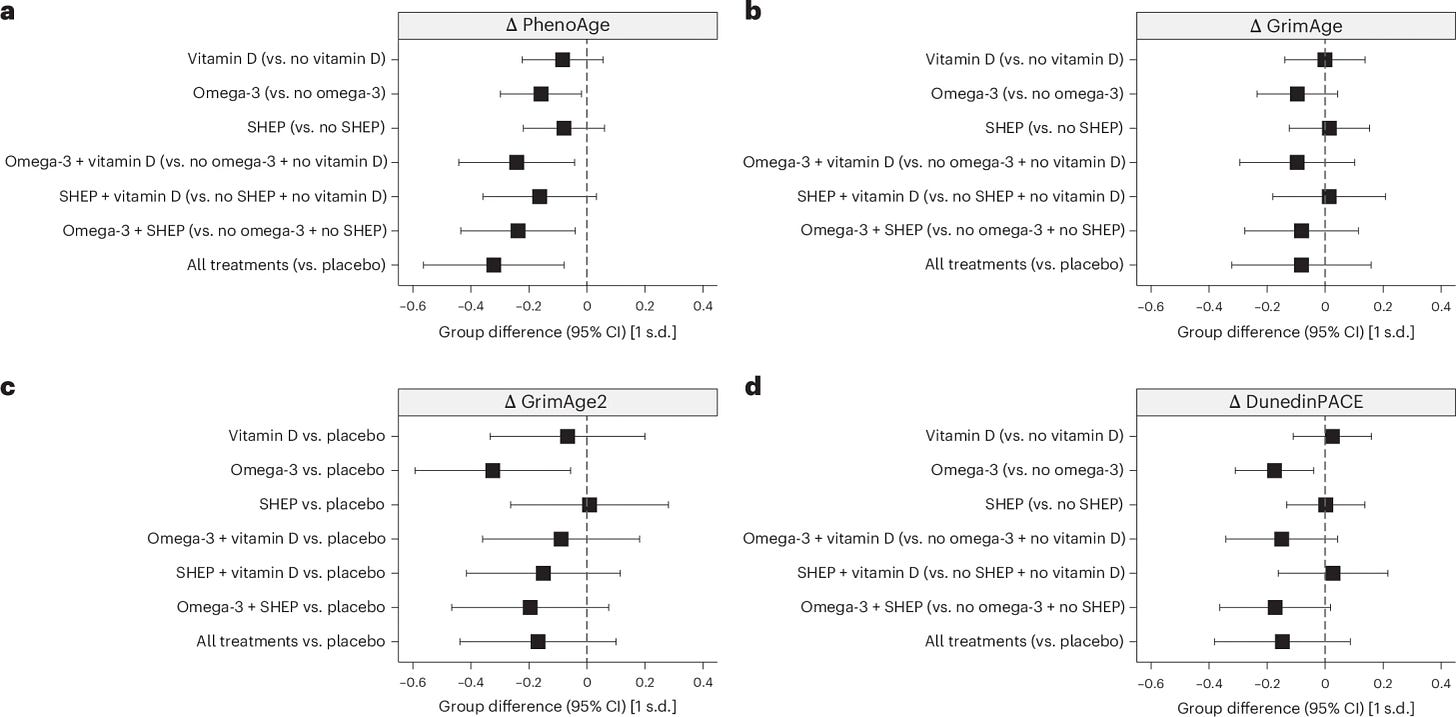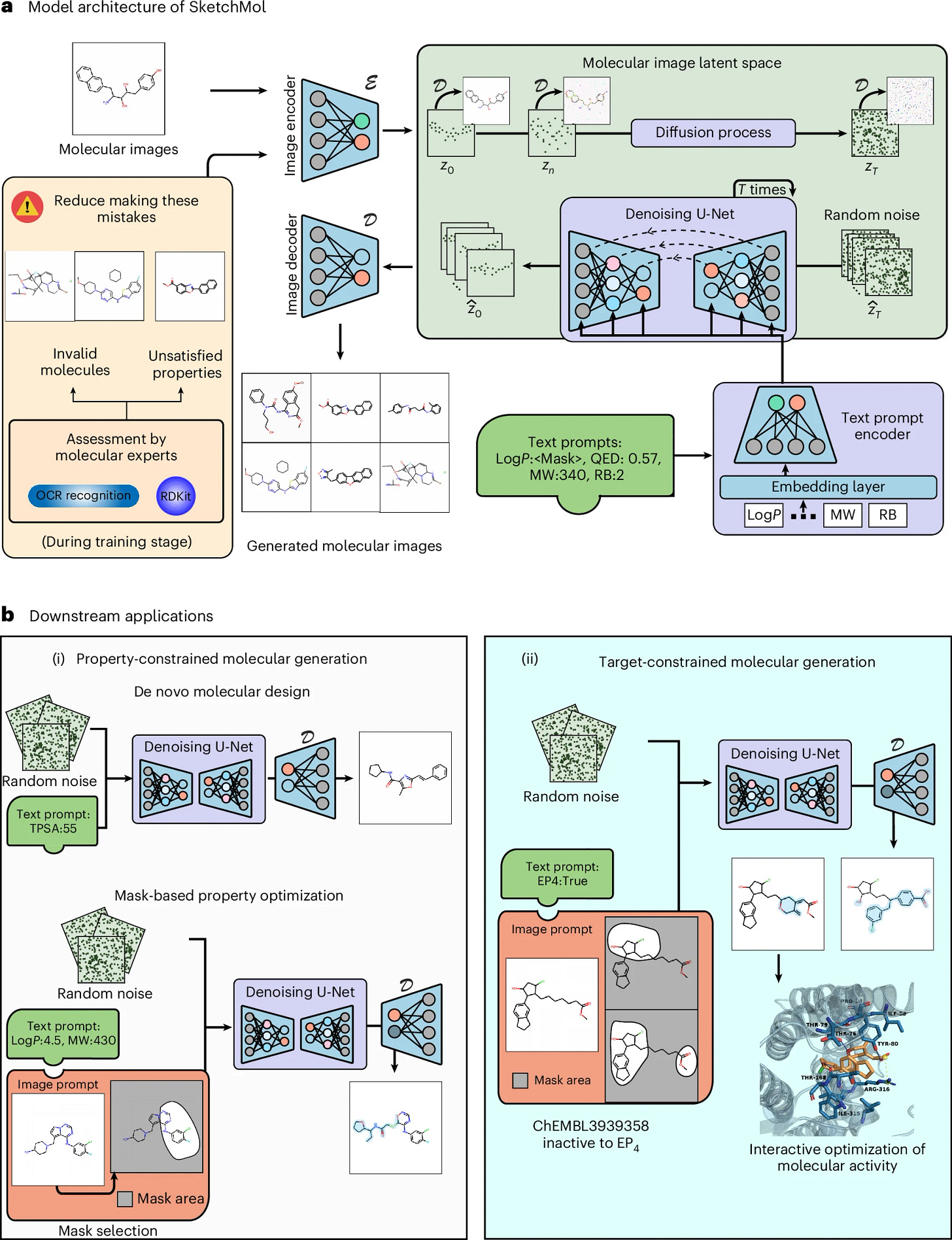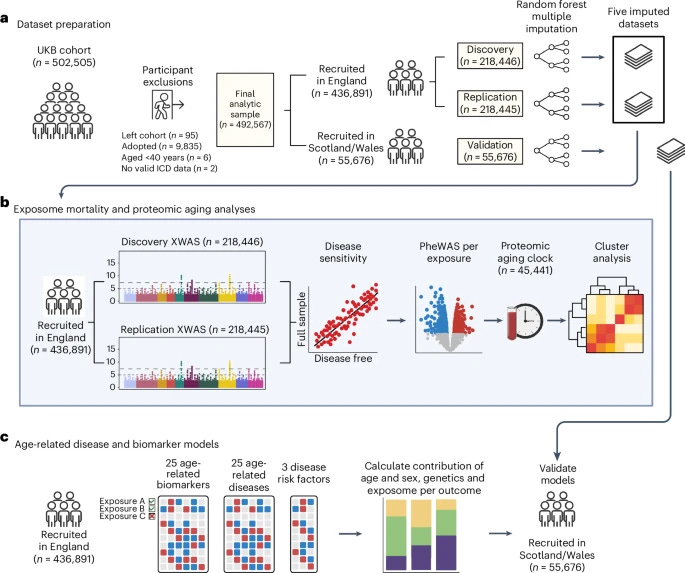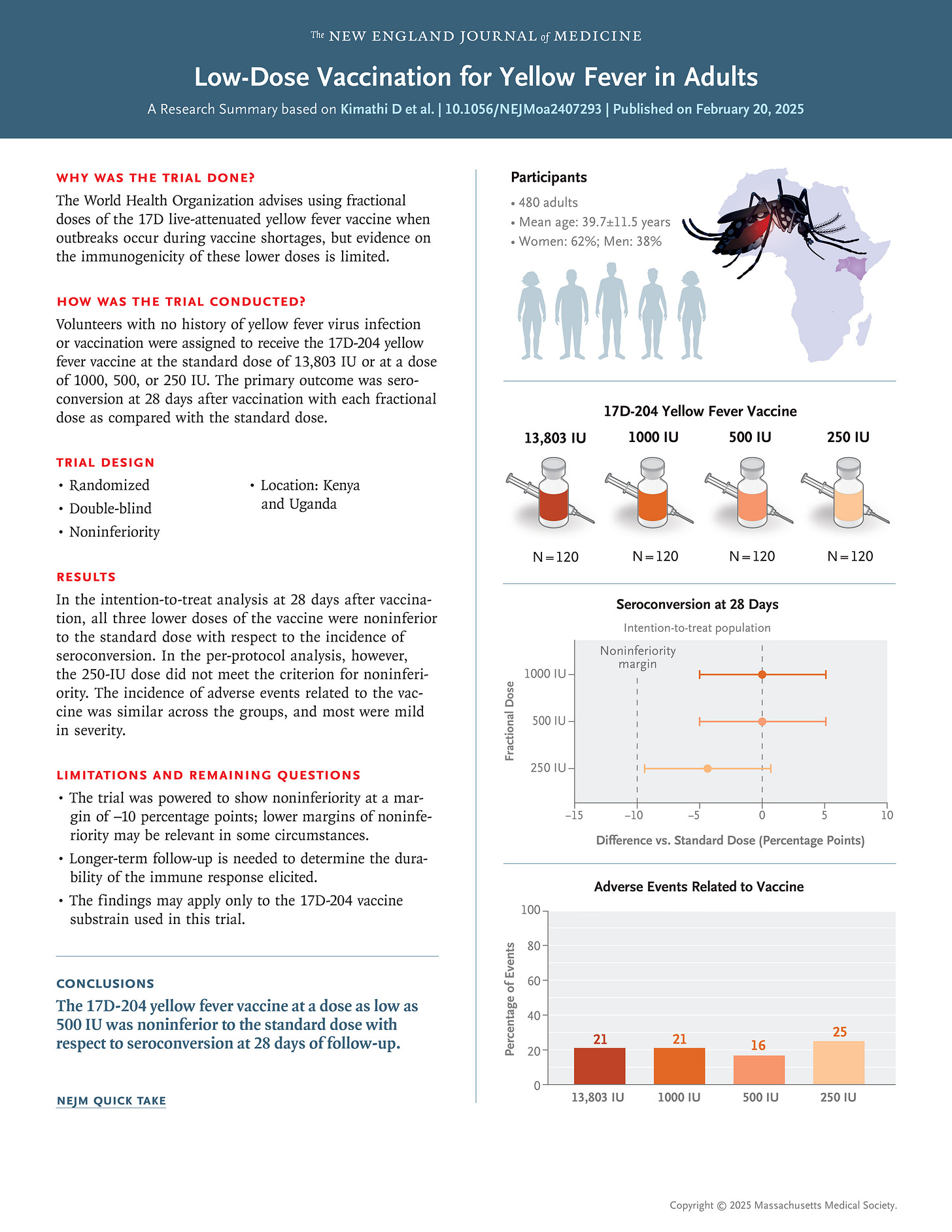HealthByte 025
This week: Vitamin D, omega-3, and exercise slow aging, reduced yellow fever vaccine doses show promise, and less frequent mammograms are as effective as annual screenings for breast cancer.
Welcome to HealthByte, your curated biweekly source for the latest breakthroughs in health and life science!
Bytes of Research
1. Individual and additive effects of vitamin D, omega-3 and exercise on DNA methylation clocks of biological aging in older adults from the DO-HEALTH trial
(Nature Aging)
TL;DR: Vitamin D supplementation, omega-3 intake, and exercise all contributed to slower aging in older adults, with the combination of all three showing an overall additive effect.
Researchers explored whether vitamin D supplementation, omega-3 fatty acid supplementation, and a simple home exercise program could slow biological aging in older adults, involving 777 participants who received one or more of these interventions over three years. Building on previous studies that linked omega-3 supplementation to reduced infections and falls in older adults, the results revealed that omega-3 supplementation alone had a significant effect on slowing down four different epigenetic clocks (PhenoAge, GrimAge, GrimAge2, and DunedinPACE), which measure various aspects of biological aging.
These effects were small—standardised effects ranged from 0.16 to 0.32 units (2.9–3.8 months). However, when combined with vitamin D supplementation and exercise, the benefits were additive, suggesting that these interventions work together to promote healthy aging. The results represent progress in measuring biological aging through epigenetic clocks and could aid in evaluating interventions aimed at increasing individuals’ lifespan.

2. Low-Dose Yellow Fever Vaccine in Adults in Africa
(New England Journal of Medicine)
TL;DR: Fractional yellow fever vaccine doses as low as 500 IU achieve immune protection comparable to the standard dose, supporting dose-sparing strategies.
A new study conducted in Uganda and Kenya suggests that lower doses of the yellow fever vaccine can be just as effective as the standard dose, potentially extending limited vaccine supplies. The randomised, double-blind trial tested fractional doses (1000 IU, 500 IU, and 250 IU) of the Institut Pasteur de Dakar 17D-204 yellow fever vaccine against the standard 13,803 IU dose in adults with no prior vaccination or infection. Researchers measured seroconversion—an immune response marked by a significant rise in protective antibodies—28 days after vaccination. They found that doses as low as 500 IU were just as effective as the full dose, while the lowest dose (250 IU) showed slightly reduced effectiveness but remained highly immunogenic. Adverse event rates were similar across all groups, with most being mild. These findings support dose-sparing strategies to enhance vaccine access, especially in outbreak-prone regions.
3. Image-based generation for molecule design with SketchMol
(Nature Machine Intelligence)
TL;DR: Deep generative models capable of high-accuracy de novo drug design, represents promising bright new future for AI-driven drug discovery.
The return on investment (ROI) for research and development in the pharmaceutical industry is facing diminishing returns, with the number of new drugs developed per billion dollars halving every nine years since 1950. To address this challenge, researchers are turning to advanced tools like deep generative models, such as SketchMol, a newly developed image-based molecular generation framework.
SketchMol was trained on a dataset of 400,000 molecules from PubChem and uses a diffusion model to generate molecular structures. The framework is compared to a molecular "Photoshop," capable of tasks such as optimising physicochemical properties, sketching new molecular designs, and editing existing ones. In de novo molecular design, which involves creating new molecules from scratch, SketchMol achieved a high success rate — over 90% for single-attribute constraints and 68% when multiple constraints were applied simultaneously.
The development of SketchMol represents a significant breakthrough in AI-driven drug discovery. By automating aspects of molecular design, it allows pharmaceutical researchers to focus on more complex tasks, such as identifying promising drug targets and developing new treatments for difficult diseases.

4. Annual versus less frequent mammographic surveillance in people with breast cancer aged 50 years and older in the UK (Mammo-50): a multicentre, randomised, phase 3, non-inferiority trial
(The Lancet)
TL;DR: Less frequent mammographic surveillance is non-inferior to annual screening for breast cancer-specific survival in women aged 50 and older post-curative surgery, supporting a shift in screening guidelines.
A large UK study has found that less frequent mammographic surveillance is just as effective as annual screening for breast cancer-specific survival in women aged 50 and older who are three years post-curative surgery. The randomized trial followed over 5,200 women for a median of 5.7 years, comparing annual mammograms with biennial screening after breast-conserving surgery or triennial screening after mastectomy. Results showed no significant difference in breast cancer-specific survival, recurrence-free interval, or overall survival between groups, with a five-year breast cancer-specific survival rate of over 98% in both. These findings support a shift toward less frequent mammography in this population, potentially reducing healthcare costs and patient burden without compromising outcomes.
5. Disease diagnostics using machine learning of B cell and T cell receptor sequences
(Science Immunology)
TL;DR: A machine learning model, Mal-ID, was developed to analyse B and T cell receptor sequencing data for diagnosing autoimmune conditions and pathogen exposures with high accuracy.
Traditionally, diagnosing autoimmune conditions and pathogen exposure has relied on extensive laboratory tests, imaging, and patient history. However, a newly developed machine learning model called Mal-ID (Machine Learning for Immunological Diagnosis) offers a novel approach by analysing variable sequences of B and T cell receptors from blood samples. These receptors provide a detailed history of an individual’s immune responses to infections, vaccinations, and immune-related diseases. The Mal-ID model, trained on datasets of individuals with diseases like COVID-19, HIV, lupus, and type 1 diabetes, accurately identified immune status, achieving a high multiclass area under the receiver operating characteristic curve (AUROC) of 0.986 on external validation data.
The model demonstrated strong performance in distinguishing between distinct disease states, such as lupus, with 93% sensitivity and 90% specificity. By incorporating both B and T cell receptor data, Mal-ID can offer valuable insights into immune responses, potentially transforming diagnostic approaches and improving our understanding of immune-related diseases. With further validation, Mal-ID could become a powerful tool for clinicians to diagnose and understand a range of conditions more efficiently.

6. BFVD—a large repository of predicted viral protein structures
(Nucleic Acids Research)
TL;DR: Kim et al. introduce the Big Fantastic Virus Database (BFVD), a repository of 350,000+ predicted viral protein structures, providing a valuable tool for viral evolution research.
Kim et al. recently introduced the Big Fantastic Virus Database (BFVD), a new resource featuring over 350,000 predicted viral protein structures. These structures were generated using ColabFold, an open-source tool that combines MMseqs2 (a fast algorithm for searching protein databases) with AlphaFold2 (an artificial intelligence-based model for predicting protein structures). BFVD fills an important gap in existing structure databases. For example, the AlphaFold Protein Structure Database (AFDB)—which contains over 200 million predicted structures—largely excludes viral proteins. By focusing specifically on viruses, BFVD provides a valuable resource for studying viral diversity and evolution.
Currently, the accuracy of BFVD’s predictions is somewhat limited due to the nature of viral proteins. Many viral proteins have few or no close relatives in existing databases (55% of BFVD entries are unique, compared to 25% in AFDB), making structure prediction more challenging. However, despite these limitations, BFVD represents an exciting step forward for virology and structural biology. The Big Fantastic Virus Database is freely available online at bfvd.foldseek.com.
7. Integrating the environmental and genetic architectures of aging and mortality
(Nature Medicine)
TL;DR: The exposome – an individual’s total lifetime environmental exposure – plays a more significant role in aging and mortality compared to polygenetic risk scores.
A groundbreaking study has shed new light on the complex interplay between genetics and environmental factors that contribute to aging. The researchers employed an exposome-wide association study (XWAS) design, which is a type of study that examines how exposure to various environmental stressors affects human health. This innovative approach allowed them to analyse data from 492,567 individuals in the UK Biobank and identify 25 independent exposures associated with aging-related outcomes.
The results indicate that while polygenic risk scores (a measure of genetic predisposition) can explain only a small percentage of mortality variation (less than 2%), the exposome (the totality of environmental exposures an individual experiences throughout their life) explains a much larger proportion (17 percentage points). Conversely, in some cases, polygenic risk scores explained a greater proportion of variation for diseases such as dementia and certain cancers. These results provide a comprehensive map of how environment and genetics interact to influence mortality and disease risk, highlighting the critical role of environmental exposures in shaping our health outcomes.
Overall, this study has significant implications for our understanding of aging and age-related diseases, and underscores the importance of considering the exposome in clinical practice, where healthcare providers can use XWAS data to inform personalised treatment recommendations.

8. Whale song shows language-like statistical structure
(Science)
TL;DR: Humpback whale songs follow key statistical patterns of human language, suggesting that cultural transmission shapes complex vocal communication across species.
Humpback whales sing long, structured, and evolving songs that are culturally transmitted within populations, much like human language. Arnon et al. analysed eight years of whale song using methods originally developed for studying how infants learn words and found that whale songs follow a Zipfian distribution—a mathematical pattern found in all human languages, where a few elements are used frequently while most are rare. This pattern, along with other hallmarks of language such as structured sequences and brevity of common phrases, suggests that cultural transmission shapes the structure of whale songs in a way similar to human language. These findings highlight a connection between human and animal communication, emphasising the role of learning and cultural evolution in shaping complex vocal systems. A video with the humpback whale speech can be found at this link.
Other pieces we’ve been reading this week!
Evo 2 Can Design Entire Genomes: A new AI model for biology, released today by Arc Institute and NVIDIA, can predict which mutations within a gene are likely to be harmful and even design small, eukaryotic genomes. (Asimov Press)
Can AI write your PhD dissertation for you? I spent four days trying to get OpenAI's new tool Deep Research to research and write a complete dissertation. This is what I discovered. (The Future of Being Human, Substack)
The rise of agentic AI teammates in medicine (The Lancet)
Can the Human Body Endure a Voyage to Mars? In the coming years, an unprecedented number of people will leave planet Earth—but it’s becoming increasingly clear that deep space will make us sick. (The New Yorker)
Are noise-cancelling headphones impairing our hearing skills? Some audiologists are beginning to worry: Some specialists suspect that constantly filtering out background noise may have unintended consequences (The Guardian)


